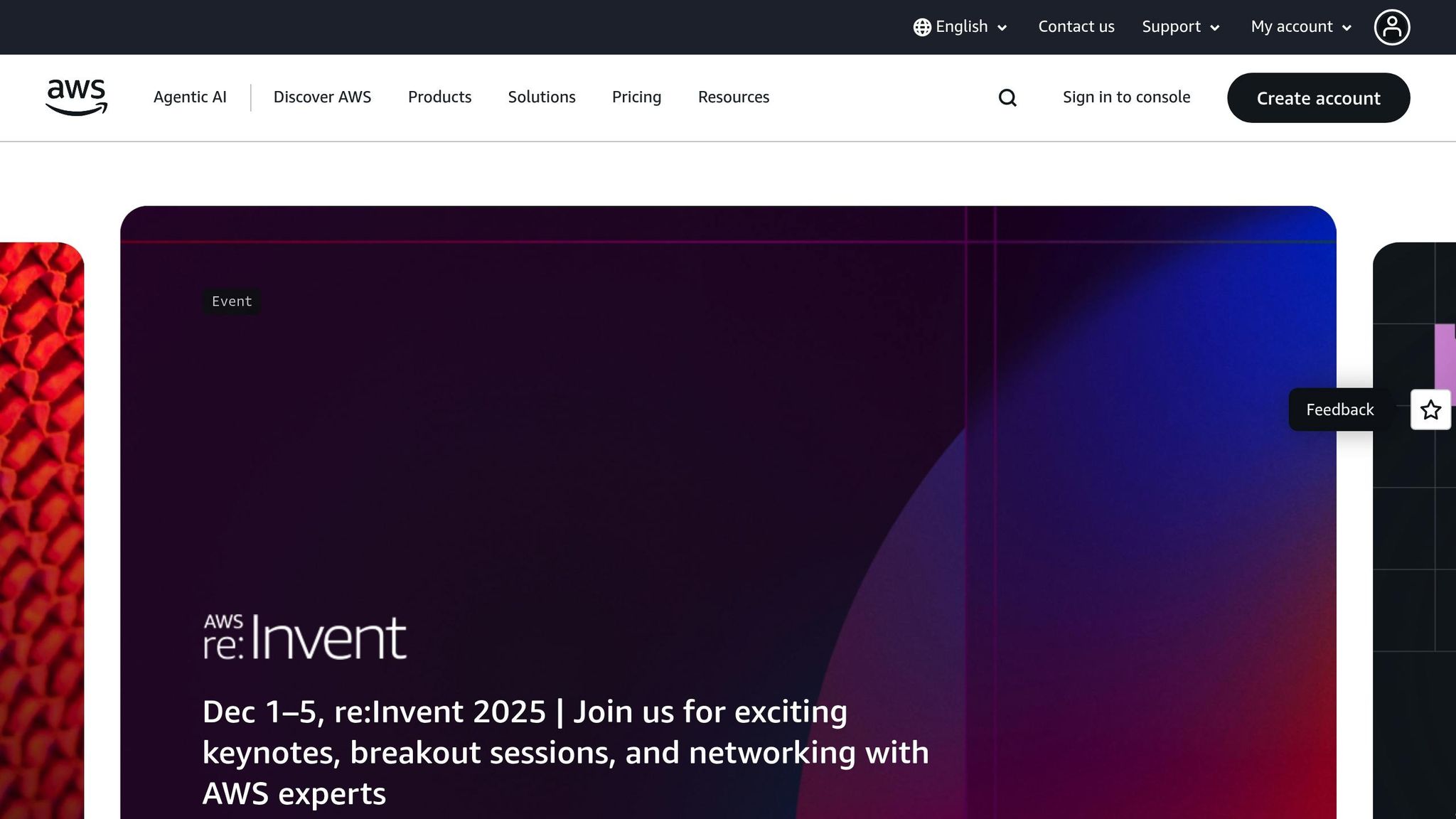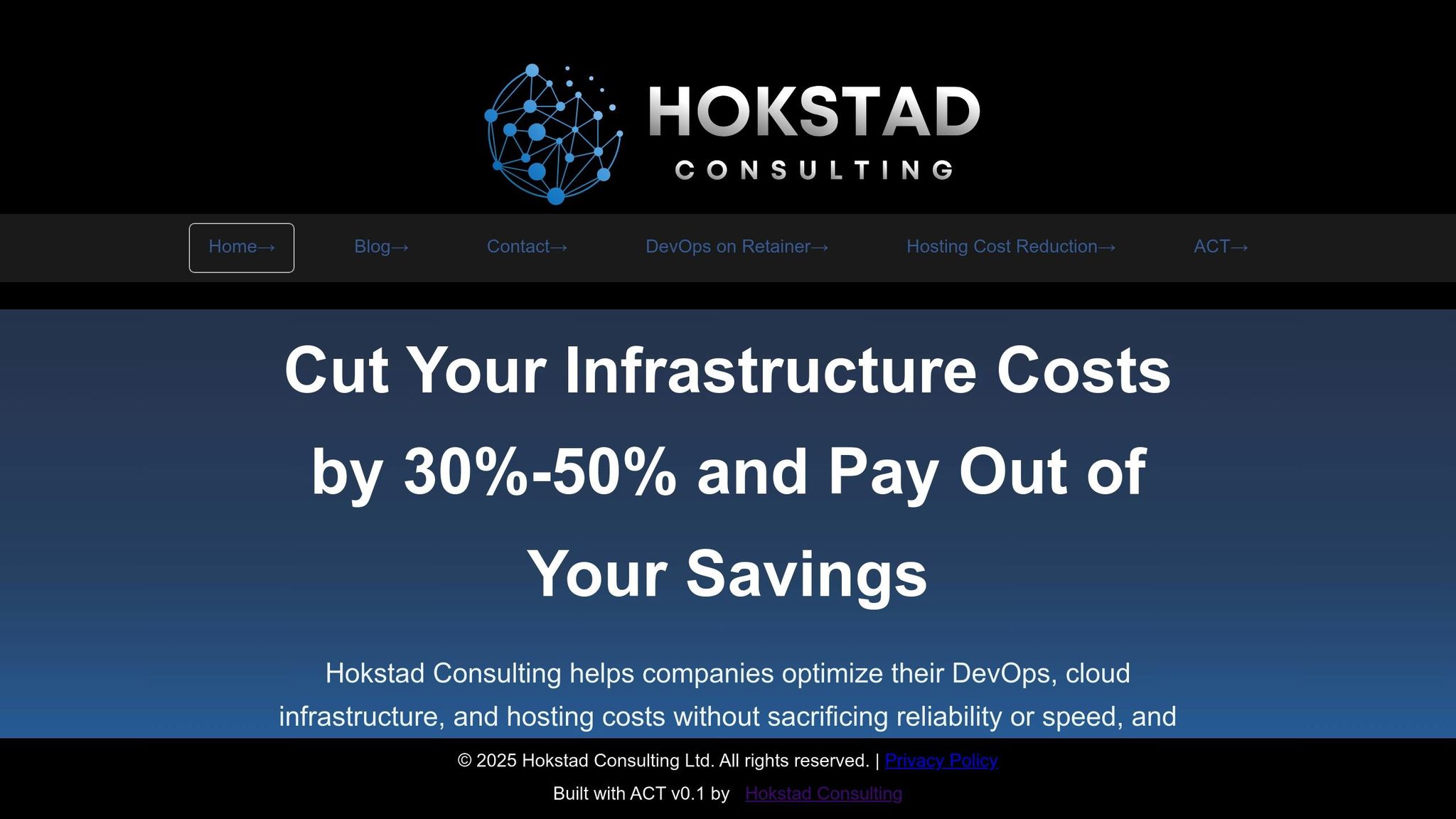Cloud costs are spiralling out of control for many UK businesses. Over half have exceeded their budgets, and 30% of cloud spending is wasted due to poor visibility. AI offers a solution by improving forecasting accuracy, automating resource management, and reducing inefficiencies.
Here’s how AI transforms cloud cost forecasting:
- Scenario Planning: Simulate
what if
cases, like seasonal traffic surges or application migrations, to predict spending. - Advanced Models: AI uses tools like ARIMA and LSTM to analyse historical data and predict future trends.
- Automation: AI automates scaling, anomaly detection, and resource optimisation, cutting waste by up to 30%.
- Real-Time Insights: AI adjusts forecasts instantly based on usage fluctuations, ensuring budgets stay on track.
Hokstad Consulting, a London-based firm, specialises in AI-driven cloud cost management. Their tailored solutions have helped UK businesses cut costs by 30–50%, with no upfront risk. Their approach combines AI tools, local expertise, and continuous support to deliver lasting results.
AI is reshaping cloud cost forecasting, turning it into a precise, automated process that saves money and improves efficiency.
AI Agents Are Changing AWS Cost Prediction

How AI Improves Scenario-Based Forecasting
AI has revolutionised cloud cost forecasting, turning it from a guessing game into a precise, data-driven process. By analysing vast amounts of information and uncovering patterns that traditional methods often overlook, AI provides insights that help UK businesses tackle the challenges of predicting cloud spending across different scenarios.
Advanced Data Analysis and Pattern Detection
The sheer scale of cloud data can be overwhelming. For instance, Google Cloud offers more than 70,000 SKUs, making it nearly impossible for manual analysis to uncover cost-saving opportunities [6]. While human analysts might struggle with this complexity, AI thrives in such environments, identifying hidden connections and trends.
AI systems process historical data to predict future patterns with impressive accuracy [3][2]. They analyse usage trends across seasonal, weekly, and even hourly cycles, helping organisations understand when their cloud usage is likely to spike or drop. This kind of detailed pattern recognition enables businesses to allocate resources more effectively and avoid overspending [3].
A practical example is Google Cloud's Gemini Cloud Assist, introduced in June 2025. This AI-powered tool uses pattern recognition to evaluate cloud resource usage, highlight inefficiencies, and offer tailored cost-saving recommendations. Developers and DevOps teams can access these insights through the Cloud Hub Cost Optimisation dashboard, while finance and FinOps teams benefit from AI-driven cost analysis and reporting via Cloud Billing.
By connecting diverse data points, AI creates a clear picture of demand fluctuations, forming a solid foundation for accurate predictive models tailored to various cost scenarios [4].
Predictive Models for Scenario Planning
AI leverages sophisticated models to simulate and predict cloud costs under different scenarios. Time series forecasting models like ARIMA, LSTM, and Prophet have shown great promise in this area. Research conducted by Smith et al. in 2023 revealed that these models could cut unnecessary cloud spending by as much as 30% [7].
These models are dynamic, adapting to changing variables such as fluctuating demand, pricing adjustments, and evolving usage trends [8]. Unlike static methods, AI tools provide real-time tracking and instant updates, which is especially useful during unexpected events like demand surges or seasonal changes.
Reinforcement Learning (RL) models push these capabilities even further. A 2022 study by Li et al. demonstrated that RL-based auto-scaling models improved resource usage performance by up to 25% compared to traditional methods. More advanced techniques, such as Deep Q Network (DQN) and Proximal Policy Optimisation (PPO), achieved a 30% boost in efficiency while cutting cloud spending by 27% [7].
These predictive tools empower businesses to confidently explore what if
scenarios, whether they're preparing for Black Friday traffic, scaling up for seasonal workforce changes, or migrating applications. AI's ability to simulate and adapt ensures that resource allocation stays efficient and cost-effective.
Intelligent Automation for Cloud Cost Management
AI doesn't stop at forecasting - it also automates cloud cost management. By combining machine learning, real-time analytics, and automated systems, AI can predict usage patterns, detect anomalies, and optimise resource allocation [7]. This level of automation eliminates delays in addressing cost issues.
Predictive analytics enable businesses to anticipate future demand and adjust resources proactively, significantly reducing waste [7]. AI systems continuously monitor resource usage, scaling services up or down based on forecasts rather than waiting for reactive thresholds.
One standout feature is anomaly detection. AI can spot unusual spending patterns within minutes, alerting teams before small issues escalate into major problems. This capability is particularly valuable for UK businesses managing multi-cloud environments or operating across time zones.
Beyond scaling decisions, AI tools streamline reserved instance purchases, identify idle resources for deactivation, and balance workloads across various pricing tiers. This comprehensive automation ensures that cost management becomes an ongoing process, rather than a sporadic task.
The growing popularity of AI-driven forecasting among FinOps practitioners in 2025 reflects its importance in managing cloud costs [5]. By transforming scenario-based forecasting into an automated and precise process, AI has become an indispensable tool for businesses aiming to optimise their cloud spending.
Best Practices for AI-Driven Cloud Cost Forecasting
Making the most of AI-driven cloud cost forecasting isn’t just about deploying the technology - it’s about using it strategically. For UK organisations, this means understanding cost drivers, tailoring models to local standards, and keeping them updated regularly.
Identifying Key Cost Drivers
To build an effective AI forecasting model, it’s essential to pinpoint the key factors influencing costs. These typically fall into three categories:
- Fixed costs: Predictable charges like reserved instances that remain constant.
- Variable costs: Fluctuating expenses such as compute hours, storage, and data transfer.
- Seasonal costs: Costs tied to spikes in demand, which are often predictable.
AI workloads, in particular, require careful cost analysis. For example, processes like prompt tuning and fine-tuning rely on a quantity × rate
formula to estimate expenses. The type of AI system you use also plays a role. Closed systems from third-party vendors may charge based on tokens in/out
(essentially the number of words processed), while open platforms or self-hosted AI models focus on infrastructure costs like GPU and RAM usage [9].
Don’t overlook the hidden costs of maintaining accuracy, such as ongoing data cleaning and expert reviews. These are vital for preventing unexpected budget overruns once the model is operational [9].
Practical steps can also make an immediate difference. For instance, using shorter input prompts can reduce costs by 15–25% [9]. However, the biggest savings usually come from a comprehensive approach - aligning technology, platform choices, scaling strategies, and purchasing decisions. It’s equally important to establish clear accountability for cloud costs before starting any forecasting initiative. This ensures everyone knows who is responsible for monitoring and managing expenses [1].
Once cost drivers are identified, the next step is to adapt forecasts to the UK’s specific standards.
Adapting AI Forecasts for UK Standards
For AI-driven forecasts to be effective, they must align with UK business norms and regulations. This means reporting all costs in pounds sterling (£), using DD/MM/YYYY for dates, and applying metric units for storage and bandwidth. Automated policies should also be scheduled to match UK business hours (9:00–17:30 GMT/BST) [10].
Regulatory requirements and data residency concerns are equally important. Many UK organisations prefer to keep data within national borders to comply with regulations or meet business needs [10]. Setting clear rules about where workloads can be hosted ensures compliance while keeping costs manageable.
As highlighted by an expert from Wiz:
You can't optimise what you can't see, so without cost management, your choices for cutting costs are limited to generic, catch-all practices, severely reducing the effectiveness of your efforts.– Wiz [10]
Good financial governance starts with accountability. Assign specific teams or individuals to oversee cloud spending, and use tagging (e.g., cost centre, owner, department) to track and audit expenses effectively. Monthly reviews comparing actual spending against budgets, combined with automated alerts for when costs approach predefined thresholds, are critical. Consistent naming conventions, like UK-Prod-WebApp-01
, can also simplify cost tracking and allocation [10].
Once these standards are in place, regular monitoring is key to maintaining accurate forecasts.
Regular Monitoring and Model Updates
Cloud environments evolve quickly, so AI models for cost forecasting need constant monitoring and updates to stay accurate. Use predefined KPIs and automated alerts to track performance and identify any signs of data drift. Comprehensive logs, along with techniques like backtesting, A/B testing, or shadow deployments, allow you to update models without disrupting operations [11].
Data quality is another major factor. Problems in data pipelines can degrade model performance, so it’s important to monitor drift metrics to identify trends. Backtesting with historical data provides a reliable way to evaluate prediction accuracy.
To counteract data drift, regularly retrain models using fresh data [11][4]. As the volume of data and number of models grow, make sure your monitoring infrastructure scales accordingly.
Improving forecasting accuracy is an ongoing process. Start small, set achievable goals, and collaborate closely with those managing cloud spending. This approach helps refine assumptions and improve the model over time [1]. For instance, accounting for the fact that a 31-day month is about 11% longer than a 28-day month can lead to more precise forecasts [1]. By combining diligent monitoring, timely updates, and strong financial governance, UK organisations can establish a solid foundation for effective cloud cost management.
Need help optimizing your cloud costs?
Get expert advice on how to reduce your cloud expenses without sacrificing performance.
Hokstad Consulting's AI-Driven Cloud Cost Engineering

Hokstad Consulting combines advanced AI techniques with cloud cost engineering to deliver scenario-based forecasting tailored specifically for UK businesses. Their method blends technical know-how with practical insights, addressing the unique challenges faced by organisations across the country.
Tailored Cloud Cost Optimisation
Hokstad Consulting takes a detailed approach to cloud cost optimisation, starting with a full assessment of a company's infrastructure. This deep dive helps uncover hidden opportunities to reduce costs. Instead of relying on one-size-fits-all solutions, they evaluate each client's specific setup to identify where AI-powered forecasting can make the most difference.
For example, a SaaS company managed to save £120,000 annually, while an e-commerce business improved system performance by 50% and cut costs by 30%. These changes not only delivered immediate benefits but also set the stage for long-term efficiency.
Cut Your Infrastructure Costs by 30%-50% and Pay Out of Your Savings- Hokstad Consulting
Their No Savings, No Fee
policy ensures there’s no upfront financial risk for clients. The fee is capped as a percentage of the savings achieved, aligning their success with the client’s outcomes.
To keep costs in check, Hokstad Consulting employs real-time monitoring systems that identify potential issues before they escalate. These tools compare live data against established baselines, enabling precise scenario forecasting and proactive cost management.
AI Strategy and Automated Solutions
Beyond cost optimisation, Hokstad Consulting revolutionises cloud management with AI-driven automation. This automation introduces immediate efficiencies, changing how businesses handle cloud cost management. Their AI agents can tackle complex forecasting tasks, factoring in elements like seasonal demand, regulatory constraints, and patterns unique to UK businesses.
For instance, a tech startup reduced deployment times from six hours to just 20 minutes. Another company achieved a 95% drop in infrastructure-related downtime, significantly improving reliability and cutting unpredictable costs.
Hokstad’s AI agents don’t just predict costs - they act on forecasts. They can automatically scale down resources during periods of low demand or adjust capacity in advance of expected spikes. These proactive measures allow businesses to stay ahead of demand fluctuations, ensuring both cost-efficiency and system performance.
Ongoing Support and Refinement
Hokstad Consulting doesn’t stop at initial optimisation. They provide continuous support to ensure that AI forecasting models remain accurate and effective as cloud environments evolve.
This support includes regular performance reviews and system updates, keeping forecasting models aligned with changing usage patterns and business needs. Their London-based team is on hand to monitor for data drift, fine-tune algorithms, and adapt strategies to shifting UK market conditions.
For businesses wanting extra support, Hokstad offers managed solutions that include optional DevOps services. This ensures that the technical infrastructure underpinning AI forecasting remains stable and reliable. Their hands-on approach allows companies to focus on leveraging AI insights for smarter decision-making, without worrying about the backend systems.
They also prioritise data quality, regularly reviewing cost allocation and tagging strategies. This ensures AI models work with clean, well-organised data, maintaining the consistency of the 30-50% cost reductions they typically deliver for clients. By continuously refining their systems, Hokstad Consulting helps businesses stay ahead in an ever-changing technological landscape.
Conclusion and Key Takeaways
How AI Enhances Cloud Cost Forecasting
AI takes cloud cost forecasting to a whole new level, turning it from a reactive task into a proactive financial strategy. One of its standout features is anomaly detection, which flags unusual spending patterns early, helping businesses avoid unexpected cost spikes [7]. AI also supports dynamic resource allocation, automatically adjusting capacity based on factors like predicted demand, seasonal trends, and historical data [7]. This approach ensures that businesses avoid both over-provisioning, which wastes resources, and under-provisioning, which can lead to performance bottlenecks.
Another strength of AI lies in its ability to identify subtle connections between business activities, user behaviours, and infrastructure expenses - insights that traditional methods often miss. These efficiencies not only optimise spending but also pave the way for service providers like Hokstad Consulting to offer even greater value to organisations across the UK.
Hokstad Consulting's Impact on UK Organisations
Hokstad Consulting leverages AI's potential to deliver customised cloud cost strategies tailored specifically for the UK market. By blending advanced AI tools with practical business solutions, they focus on creating tangible results for UK organisations.
For example, their AI-driven DevOps solutions have enabled UK logistics platforms to reduce cloud expenses by 31% in just two quarters [12]. This success stems from a comprehensive approach that balances immediate cost-saving measures with long-term strategic planning.
What makes Hokstad Consulting stand out is their ability to seamlessly integrate AI strategies with hands-on implementation. Their London-based team is well-versed in UK-specific challenges, such as GDPR compliance, local data protection standards, and market dynamics that affect cloud costs. This expertise ensures that their forecasting models consider key factors like regional pricing, seasonal demand shifts, and regulatory requirements.
Additionally, Hokstad Consulting offers continuous support to ensure their AI models stay accurate and effective. Through regular updates, data reviews, and performance monitoring, they adapt to changing business needs and advancements in cloud technology, consistently achieving cost reductions in the range of 30–50%. This ongoing commitment ensures long-lasting value for their clients.
FAQs
How does AI enhance scenario-based forecasting for cloud costs compared to traditional approaches?
AI brings a new level of precision to scenario-based cloud cost forecasting through advanced machine learning and data analysis. Traditional methods often rely on fixed assumptions and linear trends, which can miss the mark in dynamic environments. In contrast, AI analyses historical usage patterns, spots anomalies, and adjusts predictions in real time. This results in forecasts that are not only more accurate but also help businesses sidestep unexpected costs.
With AI, organisations can plan budgets with greater confidence and improve cost management, ensuring resources are used effectively. This forward-thinking approach minimises financial surprises and enables smarter decisions when it comes to cloud investments.
What types of AI models are used for forecasting cloud costs, and how do they handle changes in demand and usage?
AI models often employed for predicting cloud costs include time series models, neural networks, and demand forecasting algorithms. These systems dig into both historical and real-time data to uncover trends and patterns.
What sets these models apart is their ability to adapt to changes in demand and usage. They continuously learn from fresh data, updating their predictions as patterns evolve. This dynamic approach ensures forecasts stay precise and relevant, enabling businesses to manage their cloud budgets wisely and prepare for fluctuating workloads with greater confidence.
How can businesses in the UK stay compliant with local regulations when using AI for scenario-based cloud cost forecasting?
To ensure compliance, UK businesses need to align their AI-powered cloud cost forecasting tools with local laws, such as the UK GDPR and the evolving AI governance framework. It's crucial that these solutions respect data sovereignty rules and meet cloud compliance standards to minimise potential risks.
Regularly keeping up with changes to UK regulations is equally important. Businesses should adopt AI tools that emphasise transparency, accountability, and ethical practices. Seeking guidance from specialists in cloud cost management and compliance can also help organisations navigate these obligations with greater confidence.
